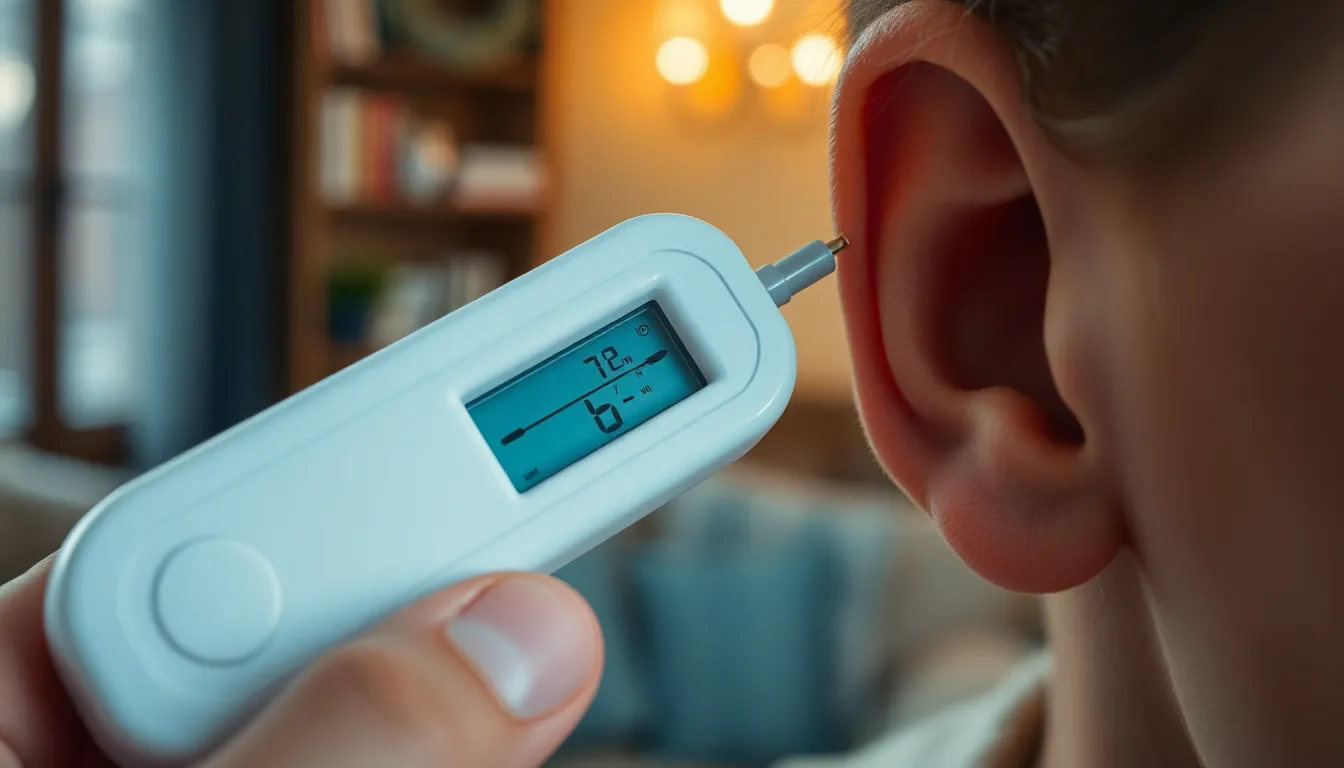Ever wondered if your ears are hot enough to fry an egg? While that might be an exaggeration, knowing the normal ear temperature for adults can be surprisingly important. It’s not just a quirky fact; it can be a vital sign of your overall health.
Table of Contents
ToggleUnderstanding Normal Ear Temperature
Normal ear temperature ranges between 97.6°F and 100.4°F (36.4°C to 38°C). This range provides insight into a person’s body heat and overall health.
Definition of Ear Temperature
Ear temperature measures the thermal energy emitted by the tympanic membrane, located in the ear canal. Thermometers designed for this purpose use infrared technology to detect heat levels accurately. Such measurements reflect core body temperature closely, as the ear is closely related to the brain’s temperature regulation.
Importance of Measuring Ear Temperature
Measuring ear temperature provides valuable health insights. It’s a quick method for detecting fevers in adults, which often indicate underlying health issues. When assessed regularly, ear temperature can signal changes in health conditions, allowing timely intervention. Accurate readings depend on proper technique and equipment, ensuring reliability in clinical and home settings. Monitoring ear temperature can aid in managing illnesses effectively, particularly in case of suspected infections.
Factors Affecting Ear Temperature

Ear temperature varies based on multiple factors. Understanding these influences contributes to accurate readings.
Individual Variations
Individual differences significantly impact ear temperature. Age plays a role, with children often exhibiting higher temperatures than adults. Stress levels can also change readings; stress may elevate body temperature. Additionally, metabolic rates differ among individuals, affecting thermal energy production. Gender differences exist, as hormonal variations may lead to different temperature ranges. Health conditions, such as infections or chronic illnesses, can cause fluctuations in ear temperature. Medications, particularly those affecting circulation or the endocrine system, can also alter temperature readings.
Environmental Factors
Environmental influences affect ear temperature as well. Ambient temperature significantly impacts the thermal environment of the ear. Exposure to extreme heat or cold can temporarily skew readings. Activity level also matters; physical exertion increases body temperature, particularly in the ears. Humidity levels can play a part, as high humidity often leads to elevated body heat. Time of day affects temperature, with the lowest readings typically occurring in the morning. Understanding these factors helps in interpreting ear temperature readings accurately.
Measuring Ear Temperature
Measuring ear temperature provides quick insights into body heat. It typically reflects core body temperature closely, making it an effective health indicator.
Types of Ear Thermometers
Infrared thermometers dominate the market for ear temperature measurement. They offer non-invasive and swift readings. Some models include digital displays for easy reading. Special features, such as memory settings, aid in tracking temperature over time. Ear thermometers can also come with adjustable ear tips to suit different ear sizes, enhancing comfort and accuracy.
Best Practices for Accurate Measurement
To ensure accuracy, users must follow specific practices during measurement. Clean the ear thermometer before and after each use. Holding the thermometer correctly positions it in the ear, maximizing accuracy. For optimal results, avoid taking measurements after recent exposure to extreme temperatures. Using the thermometer in a quiet environment minimizes distractions and enhances focus. Finally, comparing readings at different times can provide a clearer health picture.
Normal Ear Temperature Range for Adults
Normal ear temperature for adults ranges from 97.6°F to 100.4°F (36.4°C to 38°C). This range is an essential reference point for gauging health status and detecting potential issues.
Average Temperature Readings
Average ear temperature readings for adults typically hover around 98.6°F (37°C). This figure represents an accepted standard for core body temperature. Despite that, some individuals may display slightly higher or lower temperatures within the normal range. A variety of external conditions can influence these averages. Regular monitoring helps establish personalized baselines over time.
Variations in Temperature Readings
Variations in temperature readings emerge from several factors beyond personal health. Age influences normal ear temperatures, with younger adults sometimes showing higher temperatures compared to their older counterparts. Stress levels can lead to temporary spikes in body heat, affecting readings. Gender differences also contribute, as hormonal fluctuations in women may cause variations. Other influences include health conditions such as infections or illnesses, which frequently lead to elevated temperatures. Additionally, medications like antipyretics can lower temperature readings, complicating assessments. Therefore, being conscious of these variables is crucial for accurate interpretation.
When to Seek Medical Advice
Monitoring ear temperature is crucial for identifying health issues. Specific symptoms may indicate the need for professional evaluation.
Signs of Fever or Infection
Fever often manifests as an ear temperature exceeding 100.4°F (38°C). Symptoms such as chills, persistent coughing, or unusual fatigue warrant attention. Individuals might also experience ear pain or drainage, suggesting infections. Additionally, rashes or headaches can accompany significant temperature changes, indicating an underlying condition. Observing any combination of these signs should prompt a visit to a healthcare professional.
Impact of Abnormal Temperature Readings
Abnormal ear temperature readings can signal serious conditions. Elevated temperatures may indicate infections or inflammatory responses in the body. Readings below normal indicate potential hypothermia or other health issues. Persistently low or high temperatures can disrupt daily functions and may require medical intervention. Seeking advice from a healthcare provider is advisable when readings consistently fall outside the normal range.
Monitoring ear temperature is a vital aspect of maintaining health. Understanding what constitutes a normal range empowers individuals to recognize potential health issues early. Regular checks can reveal changes that might require medical attention. By being aware of the factors that influence ear temperature, adults can make informed decisions about their well-being. Utilizing accurate measurement techniques ensures reliable readings, making it easier to track health trends over time. Keeping an eye on ear temperature not only aids in identifying fevers but also supports overall health management.







